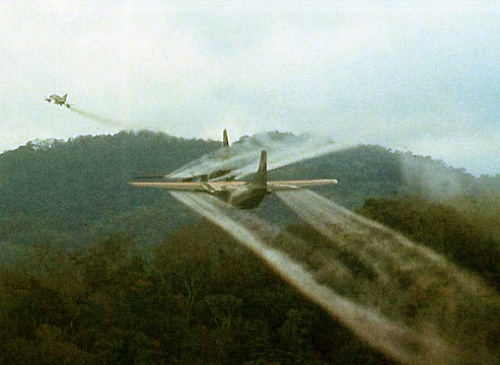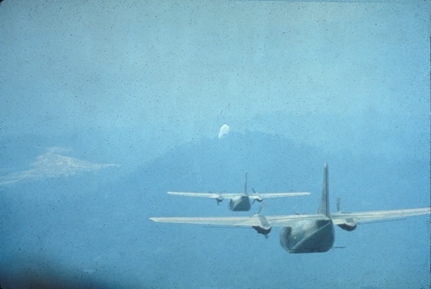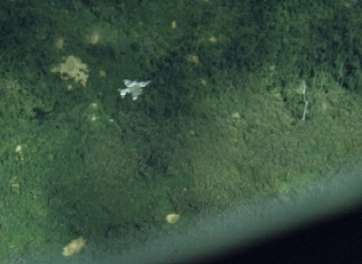
Home
FACs
More About FACs
The AO
A Shau Valley
• A Shau SF Camp
Hué
• Hué Cit Airfield
• MACV Compound
• LCU Ramp
• Hué Goose
Battle of Hué (Tet 1968)
• Trail FACs
The Missions
Visual Recon
• Sunken Sampan
Close Air Support
• CAS Munitions
• Rules of Engagement
• TACS
• Battle at Hua Cu
Interdiction
• McNamara Line
• Choke Points
Ranch Hand
Trail Dust Mission
Arc Light
SAR
Hammer 51 Rescue
Search for Jolly 23
• Msn Reports
• Search Area Map
• Search Rejoined
• Link to Past
Jungle Penetrator
Legacies
Aircraft
O-2A
Glossary
Resources
Contact
|

| |

(USAF photo)
A Trail Dust Mission
We called them Trail Dust missions.
This was the term used in the classified messages we received at our detachment tasking us to support these herbicide spray missions.
(1)
We put in a lot of the Trail Dust missions in northern I Corps (Thua Thien and Quang Tri provinces) during my tour, '68-'69.
The "Cowboys" from Ranch Hand squadron liked to spray early before the warm air started to rise off the jungle and prevent the spray from settling into the intended area.
Since we could not get to our airplanes at the Hué Citadel airfield before first light, we would stage to Danang the afternoon prior and then launch before dawn to be in the target area at first light.
|
Our main task was to mark the start point and any turn in the planned track as the
UC-123s made their run in.
Precise navigation over the jungle at low altitude was difficult enough, but the Ranch Hand crews did not have the luxury of being able to circle the area and map read into the desired start coordinates.
That is where we gave them a hand, but they also appreciated us riding shotgun for them with a flight of fighters.
We always had fighter escort and were pre-cleared for immediate response to any ground fire.
After the fighters and spray birds had checked in and been briefed, and the Ranch Hand gaggle was inbound to the start point (I remember their departure call from the IP: "Saddle up, cowboys!"), we would put in the first "Willy Pete" (white phosphorous) rocket to mark the starting point for the spray run.
If there was a turn point (not usual), we would hustle ahead of the formation to put in the second mark and then start a climb.
|

UC-123B's inbound to a FAC's mark
(Photo credit: (2)
|

An F-4 escort. One of the few times we got to
fly top cover for fighters. (Photo © Tom Pilsch)
|
By this time all the UC-123s had been converted to the jet-assisted K-models.
They sprayed at 130 knots and, despite what the manuals said, with two LAU-59 rocket pods the O-2 could not maintain that speed in level flight.
Our tactic was to start a climb once the last mark had been put in to get as much altitude as possible over the mark, let the spray birds slide under us, and then start a descending pursuit of the formation from above the spray pattern.
While all this was happening there was a constant stream of fighters making high speed low-level passes on either side of the spray path below us.
(3)
|
If a spray plane took ground fire, a loadmaster would toss out a smoke grenade.
After the spray run was completed (usually 5-6 minutes total time), we would direct the fighters to hold high (10-50,000 feet) and proceed back to the smoke grenade.
We would fire a rocket to mark a point about 2-300 meters back from the smoke and then direct the fighters to expend their ordnance, usually a close air support load (
Snakeye retarded bombs and
napalm), 2-300 meters either side of the spray track.
All of the Trail Dust spray tracks were pre-cleared as free of all friendly forces, and we were authorized to return fire without additional clearance.
Because of the heavy foliage, we seldom saw any results from these counter-fire strikes, but I would like to think that even if we missed, we got close enough to make them think twice before shooting at the big green airplanes again.
If the spray flight did not take ground fire, we usually directed the escorts to expend their ordnance against other pre-cleared targets (suspected supply or troop concentration areas) in our area of operations.
By the time they had made multiple high speed, low altitude suppression passes along the spray track, they were low on fuel and did not have enough "play time" to divert to another target other than a near-by "troops in contact" situation.
They did not like to take their bombs home, and we were more than happy to put them to work taking out some of our "hip pocket" targets (those the FACs thought were of interest but were not given high enough priority in the strike planning process).
I remember the sight and the smell of the spray.
In the early morning low angle sunlight, it appeared to have an orange hue -- at the time I thought that is how it got its name.
It smelled like a combination of motor oil and heavy bug spray (DDT).
I have since learned that they did add diesel fuel to the spray mixture.
And yes, we did fly through the mist.
We were told it was not harmful.
On one of my first Trail Dust missions, I had dinner the night before with some of the Ranch Hand crews at the DOOM (Danang Officers Open Mess).
I asked them if the stuff they sprayed was harmful, and I clearly remember the answer: "That stuff is harmless.
We have had guys drink the stuff with no problems."
I wonder how those guys are doing now.
I discovered another, more official pronouncement a few years ago in 7AF Pamphlet 55-1, Seventh Air Force In Country Tactical Air Operations Handbook (20 Mar 68).
This was the little blue book all FACs were issued but few ever read (probably the reason so many copies have survived!).
Here is the quote:
| |
"There are three types of defoliation chemicals now in use in South Vietnam.
Each formula is for a different type of foliage or mission.
None of the three types are harmful to animal or human life.
Aircrews are often splashed with it, and the ARVN troops who load the aircraft have been working with it for several years with no ill effects." (p 108)
|
|
I found it interesting that this account said the Vietnamese did the chemical handling.
Again, I wonder how those people and their kids are doing.
A sidebar. The original name for the entire US herbicidal effort was Operation Hades but this was later changed to Operation Trail Dust.
The US Air Force part of this was Ranch Hand, but the Hades name was still carried, at least into the '68-'69 timeframe, in the designation of the daily missions.
(4)
Notes:
1.
Many of these recollections have been detailed in Willaim A. Buckingham, Jr.,
Operation Ranch Hand: The USAF and Herbicides in SEA, 1961-1971, Washington: Air Force Office of History, 1982. See p 131.
[Return]
2.
Ranch Hand Association Vietnam Collection, Item No. VAS007239;
The Vietnam Center and Archive, Texas Tech University
[Return]
3.
Buckingham pp 131-132.
[Return]
4.
Buckingham p 131.
Return to Top
|
|
|




